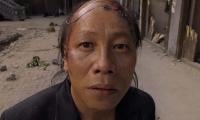Komail Aijazuddin’s latest art show is a burst of colours and shapes
The Canvas Gallery is hosting Komail Aijazuddin’s solo art exhibition titled ‘Secret History’ until April 4. Born in 1984, Aijazuddin is a visual artist and writer.
“I was attending a wedding reception some years ago when it occurred to me that the colour scheme for that most assertive of societal traditions had changed,” the artist statement released by the gallery quotes Aijazuddin as saying.
“I was no longer surrounded by the loud multicoloured patterns of blue, orange, yellow and green geometry popular before the 90s. Those psychedelic prints had been replaced with floating gauzy fabrics, sequinned pastels and walls of cascading flowers.
“I make no normative judgement about this — the evolution seems a natural one — but it did get me thinking about how shape and colour express meaning in culture.
“The old shamiana came from a very specific visual lineage. Seen carefully, it read like a ‘happy’ Islamic geometric pattern, its colours carefully coded to convey one feeling: celebration.
“Much of the present series of work investigates that idea: the way colours, codes and symbols can be used to imply meaning or, in the case with much of this work, obscure it. “The paintings might appear narrative, but they offer no obvious story. Instead, their meaning is embedded in the space where gesture, chroma and pattern intersect.
“The ‘Secret Keepers - II’ is perhaps the most superficially reminiscent of the traditional shamiana, but its pattern is actually from Moorish Spanish architecture; other symbols have more established connotations, like the acorns — medieval allegories for material abundance — hidden in the baroque pattern behind the triptych of well-dressed ‘Watchers’ (inspired by a picture by Amrita Sher-Gil).
“The thorny rose bushes of the ‘Wedding’ were traditionally used through Christian art history to denote Adam and Eve after their fall from Paradise, while the pink paisley vegetation of the ‘Readers’ has a history both pre- and post-colonialism.
“The latticework of the patterns occasionally interact with the figures — like when they form radiating religious halos in ‘Secret Keepers - I’ — or otherwise exist in a parallel, un-touching dimension (‘Autumn’); in the case of ‘Miniature’, which shows figures crowned with Persian religious halos and trapped in the traditional picture frame, they do both.
“Conceptually, the work is also about expectation and promises. Much of the visual content is an expansion of my continued interest in the objects, people, relationships and rituals that we imbibe with reverence.
“I articulated the patterns using highly concentrated dry pigments, which gives the surface a matte, velvet quality. In them the light does not bounce off the surface as it does with my gold-leaf work, but is rather absorbed.
“In some of my earlier work I used gold leaf to play with abstracting the surface, and I consider all these paintings to be abstract. But here the reflective gold (which I’ve used in nearly every piece) is now coded amidst a burst of colours and shapes.
“The figures and patterns are not necessarily meant to appear to exist on the same picture plane, although they are physically on the same canvas. The sense of floating isolation the patterning allows in these works — an abstraction through representation — is a deliberate choice. Hopefully, it encourages the viewer to read the layers of coded symbols to arrive at their own meaning.”
Aijazuddin’s work uses the vocabulary of traditional religious art — gold leaf, illuminations, altar pieces, paintings, scrolls, votive objects — to investigate contemporary ideas of divinity, belief, religion, worship, identity, statehood, belonging, and the question of what constitutes personal faith.
He holds degrees in Studio Art and Art History from the New York University and an MFA from the Pratt Institute, NY. He lives and works between New York City and Lahore.
-
 Prince Harry Arrives In UK To Fight His Phone Hacking Case
Prince Harry Arrives In UK To Fight His Phone Hacking Case -
 Nick Jonas Attempts To Take Break From Jonas Brothers With Upcoming Solo Album?
Nick Jonas Attempts To Take Break From Jonas Brothers With Upcoming Solo Album? -
 Hayden Panettiere Gets Candid About Putting Life Story On Paper
Hayden Panettiere Gets Candid About Putting Life Story On Paper -
 'Ted Lasso' Star Reveals Real Wish For Season Four Story
'Ted Lasso' Star Reveals Real Wish For Season Four Story -
 Peter Claffey 'just Hoping' For THIS Ahead Of 'Game Of Thrones' Spinoffa
Peter Claffey 'just Hoping' For THIS Ahead Of 'Game Of Thrones' Spinoffa -
 Sophie Turner Reflects On Life After Motherhood: 'Really Nice'
Sophie Turner Reflects On Life After Motherhood: 'Really Nice' -
 Royal Expert Makes Bombshell Claim On How Late Queen Tried To Protect Andrew
Royal Expert Makes Bombshell Claim On How Late Queen Tried To Protect Andrew -
 81-year-old Florida Woman Arrested After Chilling Murder Plot
81-year-old Florida Woman Arrested After Chilling Murder Plot -
 Cardi B Scores Major Earn Against Offset In Legal Battle
Cardi B Scores Major Earn Against Offset In Legal Battle -
 Bella Hadid Gets Honest About Receiving Support From 'The Beauty' Co-stars
Bella Hadid Gets Honest About Receiving Support From 'The Beauty' Co-stars -
 Nobel Foundation Reaffirms Its Core Responsibility To ‘safeguard The Dignity Of The Nobel Prizes’
Nobel Foundation Reaffirms Its Core Responsibility To ‘safeguard The Dignity Of The Nobel Prizes’ -
 Prince William, Kate Middleton Warned Of Meghan Markle’s UK Return
Prince William, Kate Middleton Warned Of Meghan Markle’s UK Return -
 Melissa Leo Reveals How Winning An Oscar Made Things Worse
Melissa Leo Reveals How Winning An Oscar Made Things Worse -
 Piers Morgan In Hospital: Here's Why
Piers Morgan In Hospital: Here's Why -
 IPhone 18 Pro Leaked: New Design Reveals Radical Corner Camera Layout
IPhone 18 Pro Leaked: New Design Reveals Radical Corner Camera Layout -
 Kung Fu Legend Siu-Lung Leung Passes Away At 77
Kung Fu Legend Siu-Lung Leung Passes Away At 77



